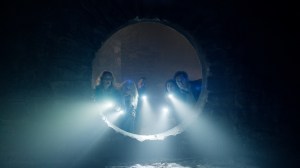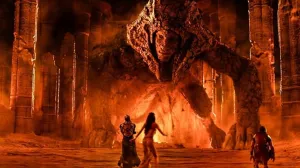This year, Tokyo Ghoul finally took is first step into the world of live-action film. Sui Ishida’s popular series made the jump from manga to anime and finally film when Kentaro Hagiwara’s take on Tokyo Ghoul was released in Japanese theaters. Earlier this year, the live-action film had a successful run in the U.S., and ComicBook was lucky enough to speak with Tokyo Ghoul‘s director about what it is like to adapt a hit series into a live-action and where he hopes the franchise goes next:
Videos by ComicBook.com
CB: How did you get involved with Tokyo Ghoul?
KH: A producer of an ad commercial production company that I work with recommended me to the producer of this film, as a potential director who could balance the cool visuals and dramatic elements, which was the goal for the film.
CB: Were you a fan of the series before you began filming?
KH: I did not know about the original comic book until receiving the offer. However, after reading the comic, I really enjoyed it and it made me want to direct the film. So I created a presentation to propose my ideas to the producer.
CB: What about Tokyo Ghoul appealed to you and made you want to direct it?
KH: I felt a lot of empathy for Kaneki’s conflict. Is it worth living if it means committing a taboo and losing your human dignity? I really liked the appeal of a university student living in Japan, which permits him a degree of economic security, and allows him to not face societal realities and pretend to live peacefully, being suddenly driven into a situation which forces him to confront the essentials of what it means to be human.
CB: Were there any elements of the anime/manga you felt were particularly important to convey in the live-action film? Were there any you felt did not translate well?
KH: I wanted to express the beauty of the artwork, which was one of the charms of the original comic, in live action as well. I tried to render the soft, subtle, pale imagery you might find in a shojo manga as a contrast to the more grotesque content.
CB: Tokyo Ghoul is known for its dark aesthetic and gory content. How did you go about bringing those elements of Sui Ishida’s work to the real world?
KH: I thought out the kagune designs and visual tone and so forth using a ratio of 70% beauty to 30% ugliness. For example, Kaneki’s kagune may be disgusting at first glance, but by giving the surface a shiny quality, and having the light sparkle when reflecting off of it, we can let it strike viewers as beautiful, too.
CB: Tokyo Ghoul does have its fantasy elements, and the kagune is a large part of that. What was it like translating the kagune into live-action?
KH: It was necessary to come up with a method of making the kagunes look as if they were growing out of the person’s body for real. For example, at first, I had them appear luminous, but for a living creature to be luminous, there has to be some necessity for it, you know? However, there is no need for the kagunes to give off light. So I gave up on having them glow. I also thought about the weight of them. It doesn’t matter that a ghoul has many times the strength of a human; all of the actors portraying them have a slender build, so if I made them too big, it wouldn’t look like their bodies could support them. For that to work, we adjusted their size, and in Hinami’s case, where size was absolutely essential, we came up with a way to make the kagunes look like they have a will of their own, and support and balance themselves. After that, we wondered what sounds a kagune would make as it moved through the air. That would change depending on their mass, so we tried a number of different sounds.
CB: Over the years, live-action anime/manga adaptations have gotten a hard time. Were you concerned about how that stereotype may affect Tokyo Ghoul? How did you try to work around the pitfalls past adaptations made?
KH: I figured that there were two features that unsuccessful live-action versions up to this point have shared. The first is that the visuals in the original comic were not updated very well for live action. The other is that they lacked a sense of reality. In other words, the performance as a whole seemed fake, and that spoiled the picture. This is why I thought extremely hard about finding just the right balance.
CB: Do you think Tokyo Ghoul is a film non-anime and non-manga fans can enjoy?
KH: I aimed to make it so that even those who are not familiar with the original comic could still enjoy it as a movie. To some extent, I made it in the genre of “going native.”
CB: Have you gotten a sense of how popular Tokyo Ghoul is with international fans? Are you excited to see how U.S. audiences react to the movie?
KH: I went to the world premiere in America, and felt the enthusiasm of the fans there. To be honest, I had no earthly idea what kind of reaction to expect, so I was relieved by how thrilled everyone was. I made it with love toward the original comic, so I believe that fans of the comic are sure to be delighted.
CB: What would you like to say to your U.S. fans before they see Tokyo Ghoul?
KH: There are many small details that fans of the original comic will pick up on, so please watch carefully for those. I think you will enjoy even the fine details.
CB: Would you like to see more Tokyo Ghoul live-action films get made?
KH: Yes, I would. I hope that things work out that way.








